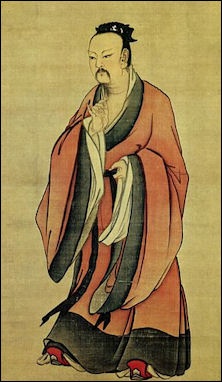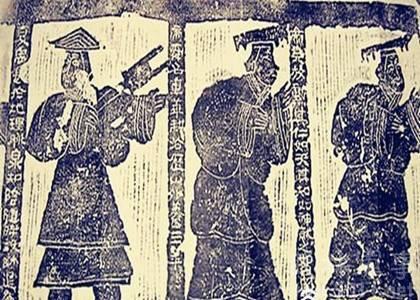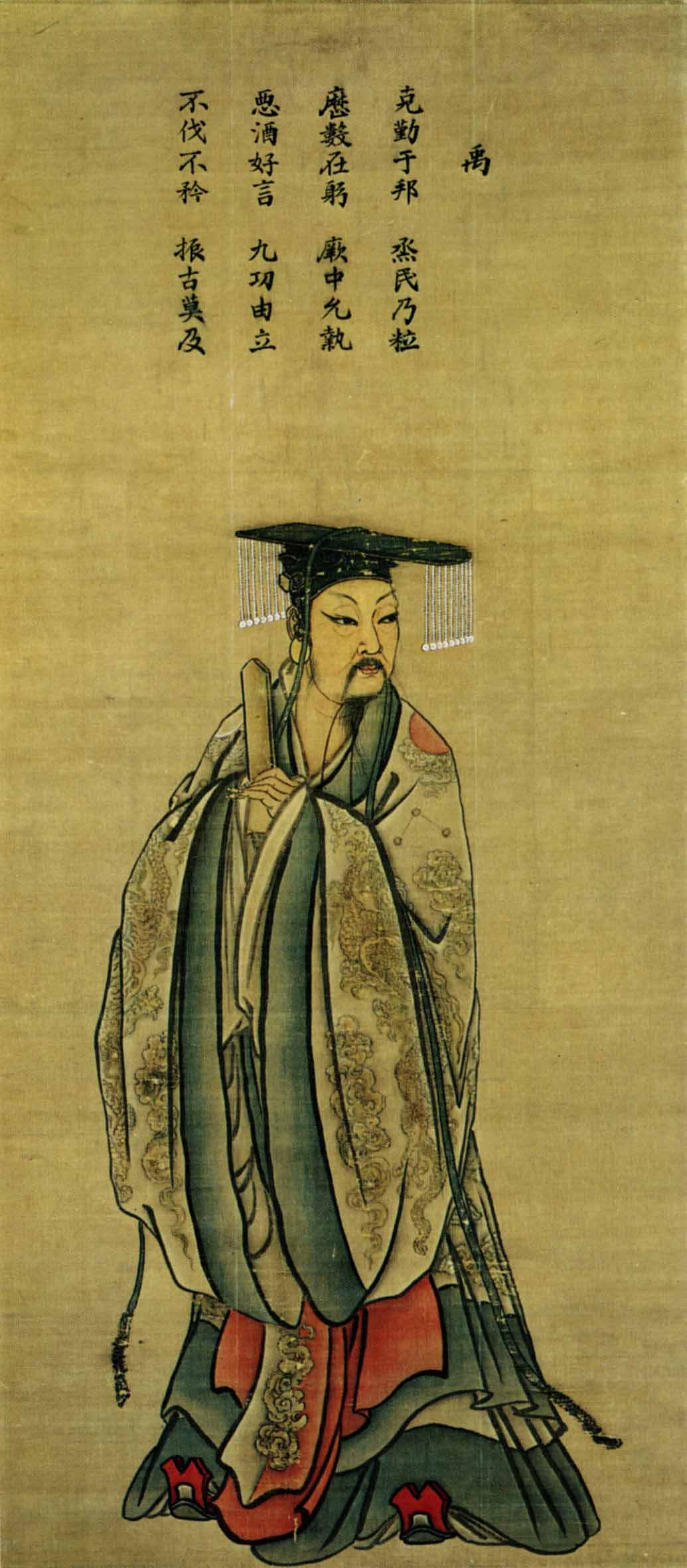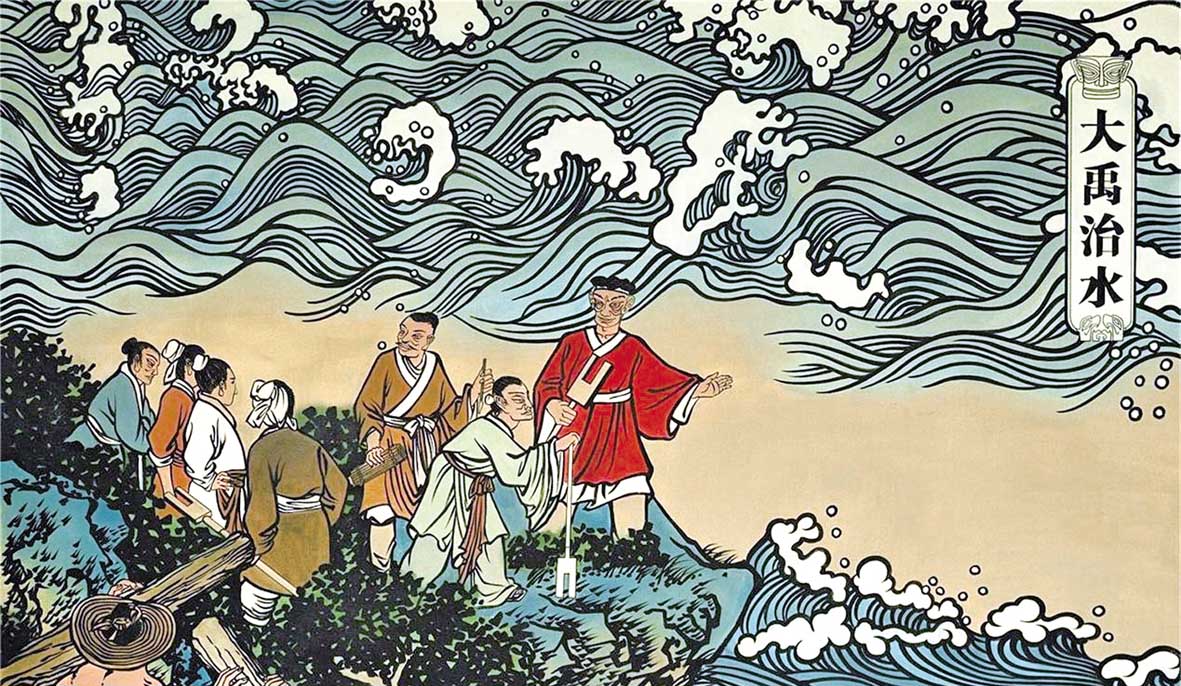The Three Sage Kings are semi-legendary characters who are credited with creating Chinese civilization. They are regarded as exemplary sovereigns, who held high moral values and under whose mandate people lived in harmony. These three emperors are Yáo 堯, Shùn 舜 and Yǔ 禹; according to the classical texts, they would reign between 2333 and 2025 B.C.
Emperor Yáo 堯
 A descendant of the Yellow Emperor (黄帝 Huáng Dì), Yáo assumed the position of ruler at the age of twenty. He is credited with creating government institutions, setting up an organized system that delegates authority to different official positions.
A descendant of the Yellow Emperor (黄帝 Huáng Dì), Yáo assumed the position of ruler at the age of twenty. He is credited with creating government institutions, setting up an organized system that delegates authority to different official positions.
The Shū Jīng 書經 or "Classic of Documents" considers it a model of benevolence, defining him as intelligent, sincere, and thoughtful, and identifies him as responsible for the unification of a multitude of states that previously existed independently.
Based on astronomical observations, Yáo determines the movements of the sun and invents the solar calendar, that is, he adapts human activity to the patterns of Heaven, harmonizing the natural and human worlds. Until then the Chinese calendar was purely lunar, that is, it was unrelated to the seasons, which are determined by the movement of the Earth around the sun. In this way, agriculture lacked a reliable pattern by which to determine the appropriate dates for planting and harvesting. The introduction of the solar calendar regulates agriculture, providing farmers with this much-needed pattern, and thus favoring the country's economic prosperity.
Summarizing, Yáo is regarded as the source of civilized behavior, promoter of the economic well-being of the people and creator of the bureaucratic apparatus of government. According to the texts, he lived about 120 years.
When deciding who to pass on the government, Yáo chose a peasant named Shùn as successor, rather than his own son, considering the latter incapable of governing. Shùn was a simple farmer who had never held official positions, but who stood out for his virtuous conduct. This election reveals one of the most important ideas of the time: the government of the virtuous man. The right to govern was based on virtue and not on inheritance.
Emperor Shùn 舜
Belonging to the common people, Shùn was chosen for his talent and righteousness as successor by Emperor Yáo. The latter, to prove Shùn's capacity as ruler, puts him in charge of the administration of a district and gives him his two daughters in marriage. Despite holding the new office and having some wealth, Shùn continues to live humbly and cultivate the land on a daily basis. Coming from a family that the texts describe as evil, he survives several assassination attempts by his relatives, but on all occasions forgives them and continues to treat them with the utmost reverence, boasting one of the virtues most valued by the later confucian thinkers, filial piety.

The Three Sage Kings.
Shùn, having demonstrated his ability as wise ruler, assumes the position at the age of 30. During his reign he offered sacrifices to the gods of Heaven and Earth and traveled through every corner of the kingdom, which he divided into twelve provinces. On his travels he established order among the people and taught ethical behavior.
Shùn creates models of ethical behavior and defines the punishments to be applied to criminals. These are, from smallest to largest magnitude: floggings, exile and death. Prison, at that time, was not regarded as a punishment and was not part of the penal system, but was used only as a means of keeping those awaiting trial. He is also regarded as the creator of the ritual because he sets out the rules by which ceremonies are to be performed.
Shùn, like his predecessor, considers his sons unworthy to rule and chooses Yǔ as his successor. He dies of a sudden illness on one of his multiple trips around the country.
 Emperor Yǔ 禹
Emperor Yǔ 禹
Yǔ had been Minister of Public Works during the reign of Shùn, a position in which he stood out in a remarkable way.
The most important achievement of Yǔ was the control of the floods of the great rivers. At that time, these floods were frequent due to the rapid sedimentation of mud in the river basins, especially in the Yellow River (黄河 Huáng Hé), and they devastated large regions. He dredges the rivers and creates canals to redirect their water, demonstrating man's dominion over nature.
The Gǔn-Yǔ Myth: 鯀禹治水 Gǔn Yǔ Zhì Shuǐ
According to legend, a large flood that lasted two generations devastated the plains of northern China during the reign of Emperor Yáo, wreaking enormous damages on crops, famines and population displacements. People left their homes to live in the mountains and in the treetops.
Yáo appoints a man named Gǔn, father of the later Emperor Yǔ, to control the floods. To do this, he uses a type of soil with miraculous properties called xīrǎng 息壤, which he steals from the gods. This soil has the ability to expand itself continuously, and so, Gǔn uses it to build dykes and dams. Despite everything, Gǔn fails in his task, and his efforts are not enough to control the floods.
During Shùn's reign, Yǔ takes over his father's task. Correctly identifying the cause of the floods (silting), he changes his strategy accordingly, dredging rivers and building canals, eventually succeeding where its father failed. According to the myth, in the course of his task Yǔ has to deal with various supernatural beings.

According to archaeological research, a large flood of the Yellow River took place around 1900 B.C. This time is several hundred years after that of the myth of Gǔn-Yǔ, but it may have served as a historical basis for its creation.
Breaking with the tradition of the election of the ruler based on his virtues, Emperor Yǔ passes on the government to his descendants, inaugurating hereditary succession and establishing the Xià 夏dynasty, considered in the classical texts as the first Chinese dynasty.
Xià 夏 Dynasty
Despite being recorded in the classical texts, we lack any archaeological evidence of the existence of Xià dynasty. The dates of its foundation, and those of the reign of the Three Sage Kings, precede in almost a millennium the first written records.
No inscription on artifacts of the time, nor in the later oracular bones of the Shāng 商 dynasty, refers to Emperor Yǔ. These references do not appear until the Western Zhōu 西周 period (1046 – 771 B.C.). Because of this, Xià dynasty is regarded by many as a legendary one, and the Shāng is held as the first historical dynasty.
Currently, it is known that the story of the Three Sage Kings was written around the 5th century B.C., a time well after the era to which these leaders allegedly belonged. Therefore, although the texts treat them as historical figures, it would be more accurate to consider them as legendary characters.
The 5th century B.C. was marked by chaos and wars, in a territory divided into multiple feudal states. Thus, the stories of the Three Sage Kings tell us much about the moral ideals that the China of the 5th century B.C. most valued and needed. These stories are an expression of the political ideas of its day, of how an exemplary ruler should be, and of the need for unification and harmony in the kingdom.
